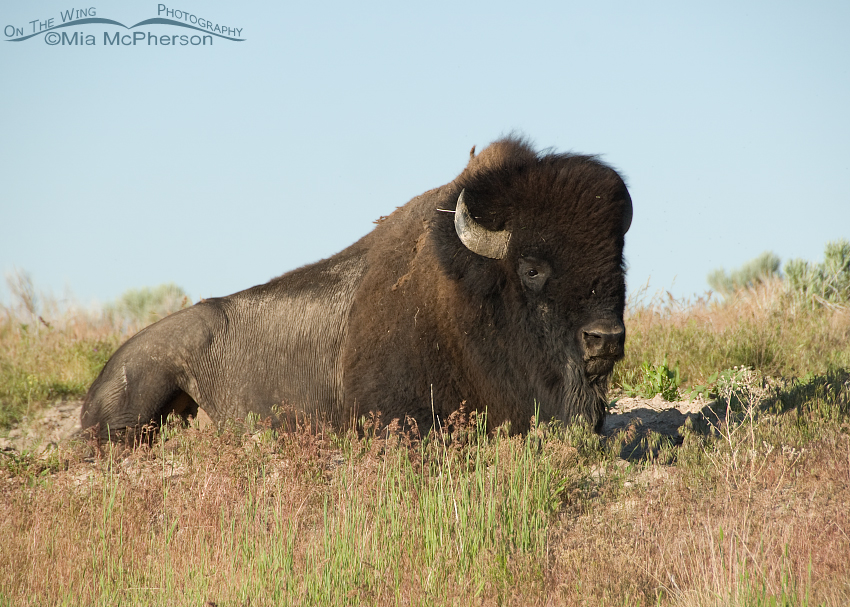 Resting Bison Bull – Nikon D200, f7.1, 1/500, ISO 250, -0.3 EV, Nikkor 18-200mm VR at 200mm, natural light
Resting Bison Bull – Nikon D200, f7.1, 1/500, ISO 250, -0.3 EV, Nikkor 18-200mm VR at 200mm, natural light
Yesterday I came across this bull Bison on Antelope Island State Park in northern Utah, it had been walking then laid down and I was hoping that the bull would take a dust bath. The Bison on the island are a wild population that roam freely over the grassy slopes. Because they are used to traffic and people they are not very skittish. They are still dangerous though and I stay inside the vehicle to photograph them.
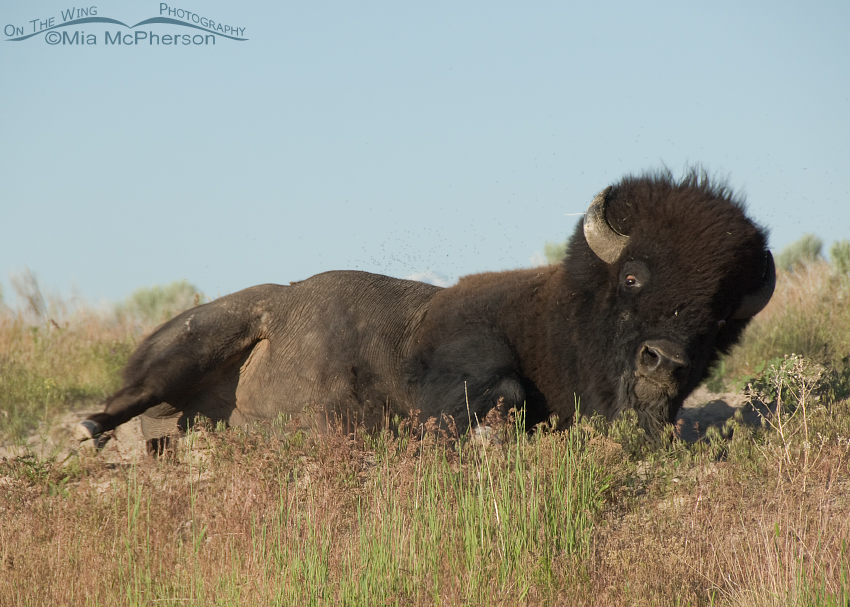 A little privacy, please? – Nikon D200, f7.1, 1/500, ISO 250, -0.3 EV, Nikkor 18-200mm VR at 200mm, natural light
A little privacy, please? – Nikon D200, f7.1, 1/500, ISO 250, -0.3 EV, Nikkor 18-200mm VR at 200mm, natural light
About May the Bison begin to shed their winter coats. It is especially noticeable on the males because the summer coat is much shorter and sleeker from the shoulders on back. This bull has lost most of its winter coat.
Note: the black/gray specks above the bull’s back are not camera dust spots, those are actually bugs. I’m not sure what type they are and I’m not going to get close enough to know!
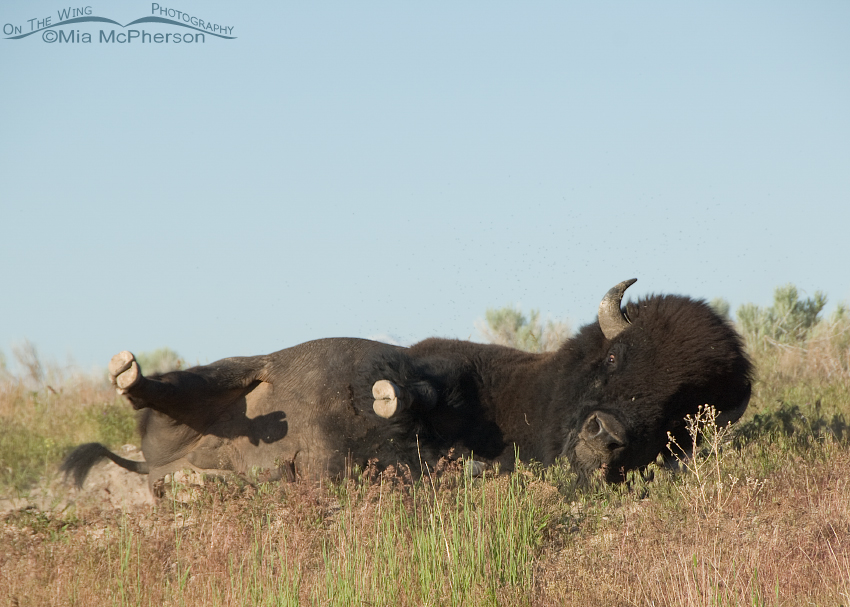 Rolling, rolling, rolling… – Nikon D200, f7.1, 1/500, ISO 250, -0.3 EV, Nikkor 18-200mm VR at 170mm, natural light
Rolling, rolling, rolling… – Nikon D200, f7.1, 1/500, ISO 250, -0.3 EV, Nikkor 18-200mm VR at 170mm, natural light
I think it is amazing to see a huge Bison; weighing up to and over 2200 pounds, rolling around on the ground with apparent ease. Wallows are common on Antelope Island State Park and Bison enjoy taking dust baths. There are several hypotheses on why Bison do this, one of which is for grooming. I can see why it might help to loosen and remove the shaggy winter coats. Another explanation is that the mud or dust helps with bites from insects.
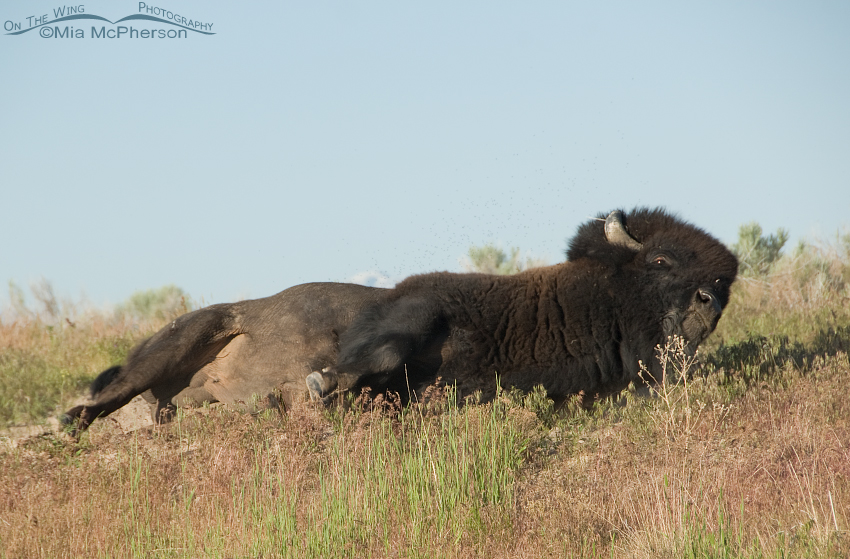 Mmmm, this feels SO good! – Nikon D200, f7.1, 1/500, ISO 250, -0.3 EV, Nikkor 18-200mm VR at 170mm, natural light
Mmmm, this feels SO good! – Nikon D200, f7.1, 1/500, ISO 250, -0.3 EV, Nikkor 18-200mm VR at 170mm, natural light
We have had a very wet spring here in northern Utah this year which may be why there isn’t much dust in my images, later in the summer I am sure there will be plenty of dust.
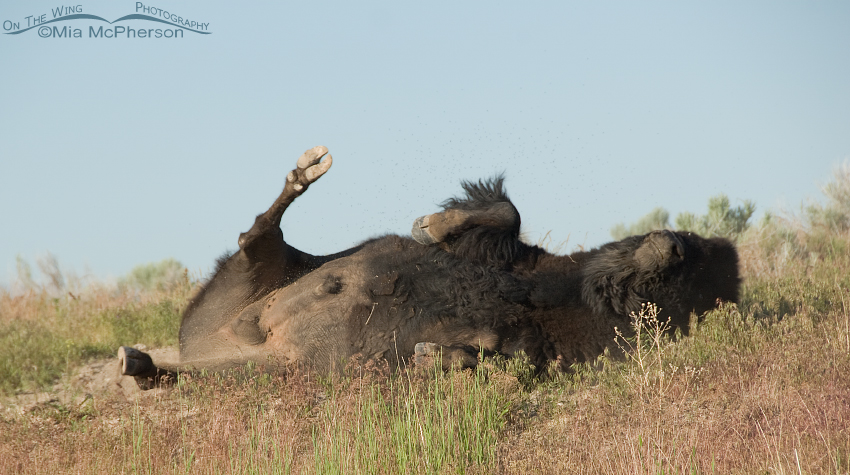 Just kicking up my heels! – Nikon D200, f7.1, 1/500, ISO 250, -0.3 EV, Nikkor 18-200mm VR at 170mm, natural light
Just kicking up my heels! – Nikon D200, f7.1, 1/500, ISO 250, -0.3 EV, Nikkor 18-200mm VR at 170mm, natural light
I haven’t been seeing the cows or newborn calves so far this spring but I am sure it won’t be long before they are more visible on the island. I think they move to areas of the island that aren’t easily accessible for humans during calving. The bulls do not participate in rearing the calves.
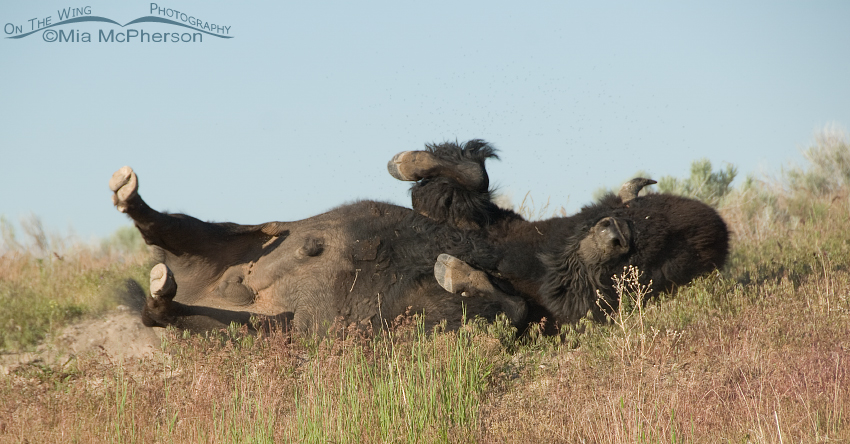 Ooooh yeah! – Nikon D200, f7.1, 1/500, ISO 250, -0.3 EV, Nikkor 18-200mm VR at 170mm, natural light
Ooooh yeah! – Nikon D200, f7.1, 1/500, ISO 250, -0.3 EV, Nikkor 18-200mm VR at 170mm, natural light
This image made me laugh out loud when I first opened it and saw it on my monitor. I don’t know that Bison feel “bliss” but this one sure looks like it is to me. I laughed again attaching it to this post, it is the funniest one of the series in my opinion.
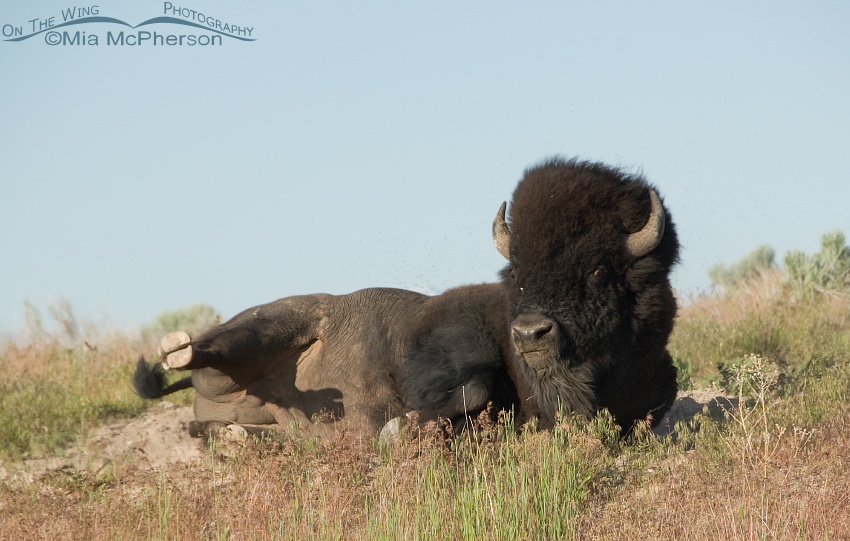 Hmmm, I am being watched! – Nikon D200, f7.1, 1/500, ISO 250, -0.3 EV, Nikkor 18-200mm VR at 170mm, natural light
Hmmm, I am being watched! – Nikon D200, f7.1, 1/500, ISO 250, -0.3 EV, Nikkor 18-200mm VR at 170mm, natural light
It is a good thing I carry my backup D200 attached to my 18-200mm VR with me every time I go out photographing because I could not get these shots with my 200-400mm VR lens, the Bison was just too close even if I had taken off the 1.4x TC. It was also nice that the wallow was near the top of a small hill so the background included the sky and distant mountain top.
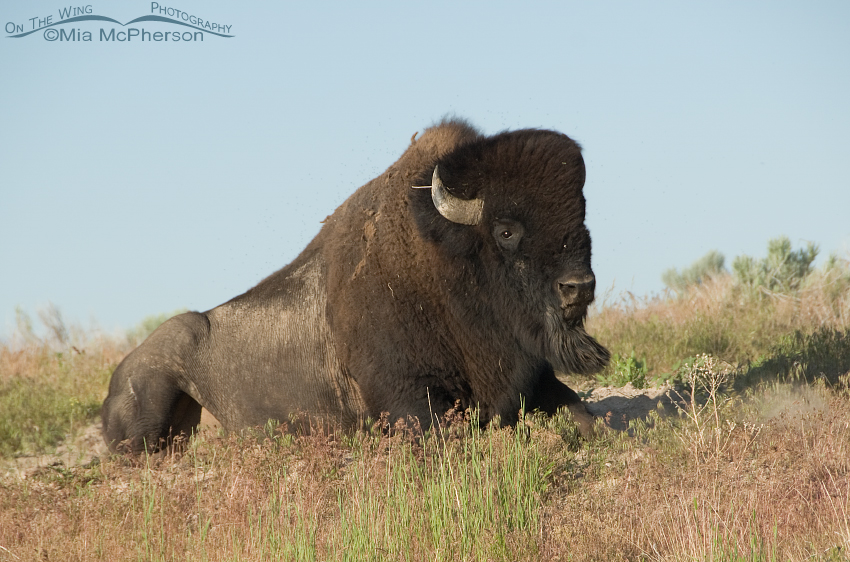 Bison getting up – Nikon D200, f7.1, 1/500, ISO 250, -0.3 EV, Nikkor 18-200mm VR at 170mm, natural light
Bison getting up – Nikon D200, f7.1, 1/500, ISO 250, -0.3 EV, Nikkor 18-200mm VR at 170mm, natural light
It is difficult for me to imagine how large the herds of Bison were in the days of the pioneers, how the ground trembled when a herd stampeded or seeing Bison in the thousands. It must have been incredible.
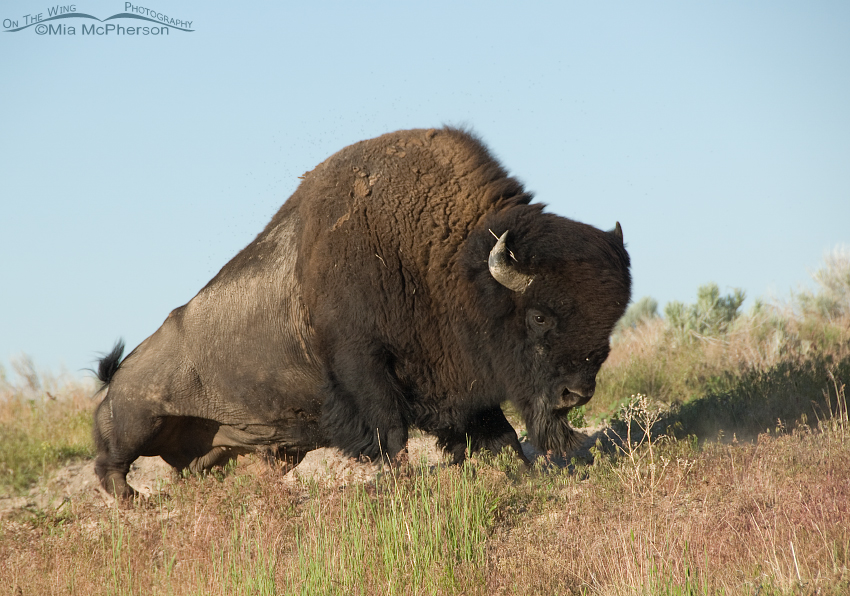 Bison getting up after a roll in the dust – Nikon D200, f7.1, 1/500, ISO 250, -0.3 EV, Nikkor 18-200mm VR at 170mm, natural light
Bison getting up after a roll in the dust – Nikon D200, f7.1, 1/500, ISO 250, -0.3 EV, Nikkor 18-200mm VR at 170mm, natural light
It must take a lot of muscle power to lift 2,200 pounds off of the ground. I have trouble lifting my camera gear some days and it sure doesn’t weigh that much!
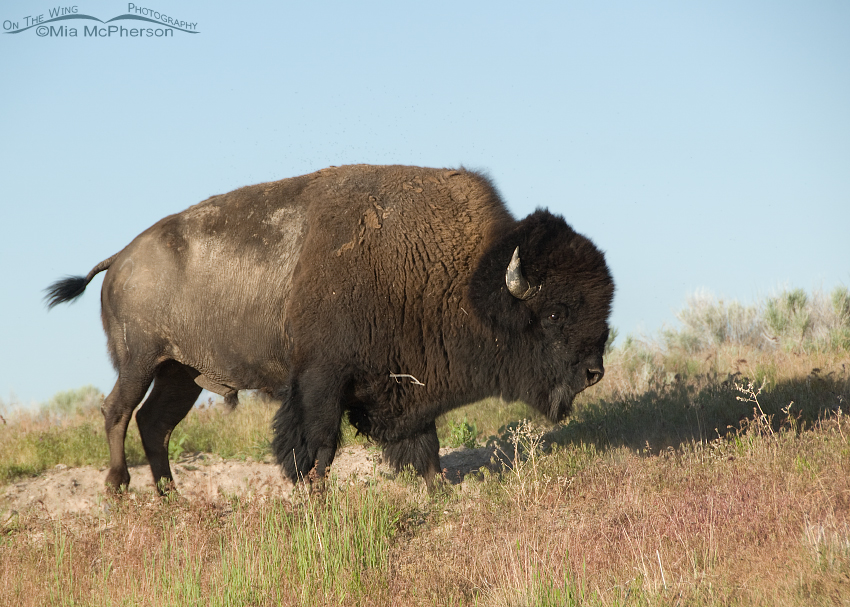 Walking away after great roll in the grass (and dirt) – Nikon D200, f7.1, 1/500, ISO 250, -0.3 EV, Nikkor 18-200mm VR at 135mm, natural light
Walking away after great roll in the grass (and dirt) – Nikon D200, f7.1, 1/500, ISO 250, -0.3 EV, Nikkor 18-200mm VR at 135mm, natural light
This dust bath didn’t last very long yet I had a great time watching and photographing it.
Life is good.
Mia
Click here to see more of my American Bison photos plus facts and information about this species.


Like you Mia, as a child on the prairies I often wondered what it would have been like to experience the great Bison herds of the past. Its hard to imagine the ground shaking. Or so I thought until I visited Kenya in 1976 and witnessed the wildebeest migration on the Mara. The ground did shake, and the noise and dust was truly something to behold. What a shame that we have destroyed opportunities for such moving experiences here in N.America .. all for greed!
As a bird person, I’m still trying to wrap my mind around the numbers of Passenger Pigeons that inhabited N. America pre-1850. There are numerous descriptions of flocks that blackened the sky for 3 days, “Alexander Wilson, America’s first ornithologist concluded that a single flock comprised 2.23 billion birds”! The largest nesting on record occurred in central Wisconsin in 1871; it encompassed 850 sq. miles and involved an estimated 136 billion birds. But by 1890, the wild population was estimated at only a few thousand birds. In 1914 the last living Passenger Pigeon died in the Cincinnati Zoo! Like the bison, the Passenger Pigeon was the victim of greedy market hunters. There are lessons to be learned here if humankind would only listen!
Glen
Glen, your visit to Kenya and seeing the wildebeest migration must have been spectacular. I can only dream of how powerful that must have been.
I grow anxious that we will soon see the extinction of other birds and animals before much longer. I truly wish humankind would listen.
Great shots…ever notice how hard it is to make out a bison’s ears in a photo? This looks like a young bull…he’s actually cute, even though he’s shaped like a muscle- packed charging machine An old ltimer told me every time my horse rolled over, she was worth $100….I wonder how much that bull was worth…in today’s economy…
Patty, I sure think in some of these images that the bull looks cute, he really enjoyed that dust bath!
LOVE the pics, that blissed out one is much, much too funny! Great series…